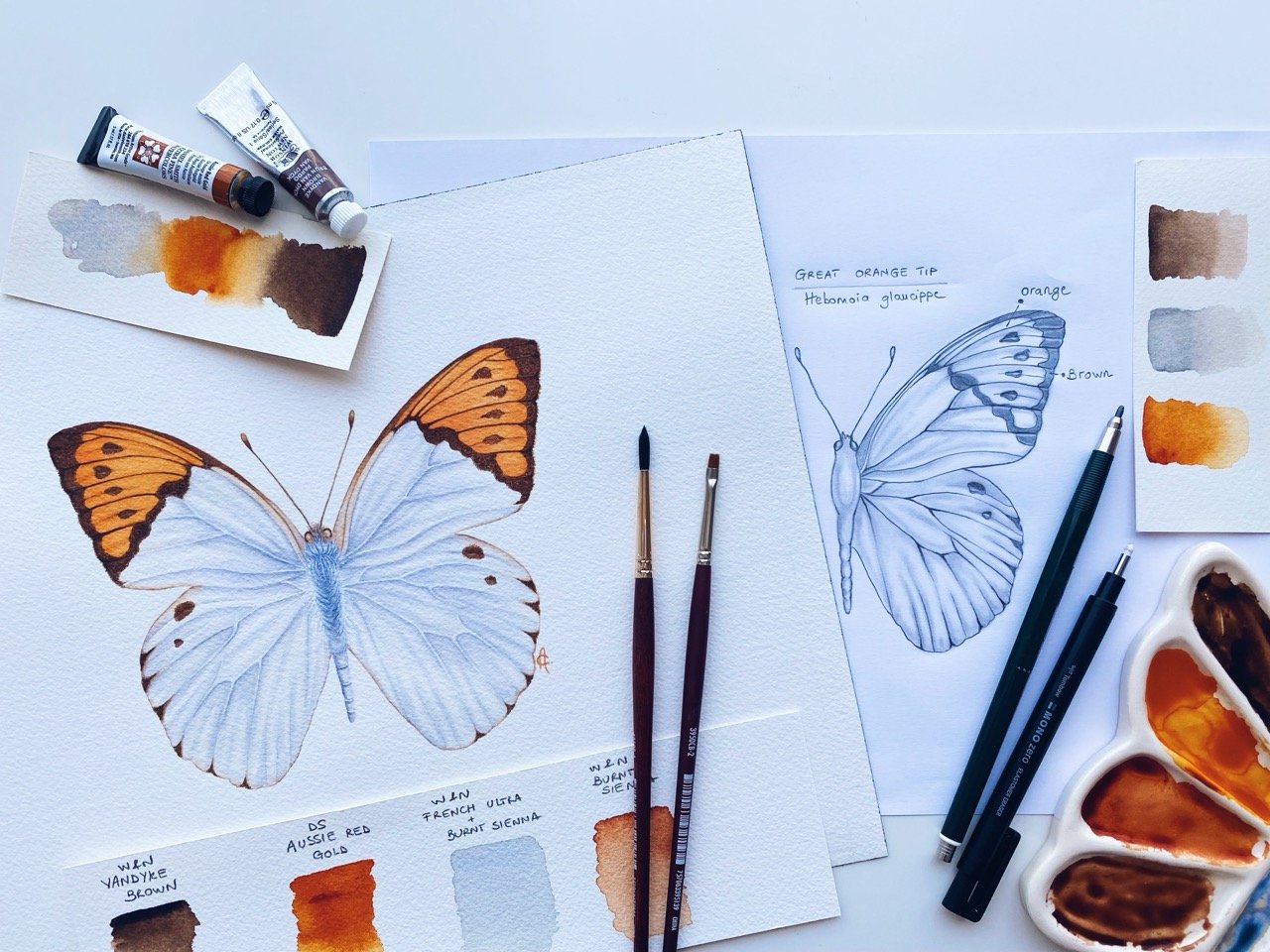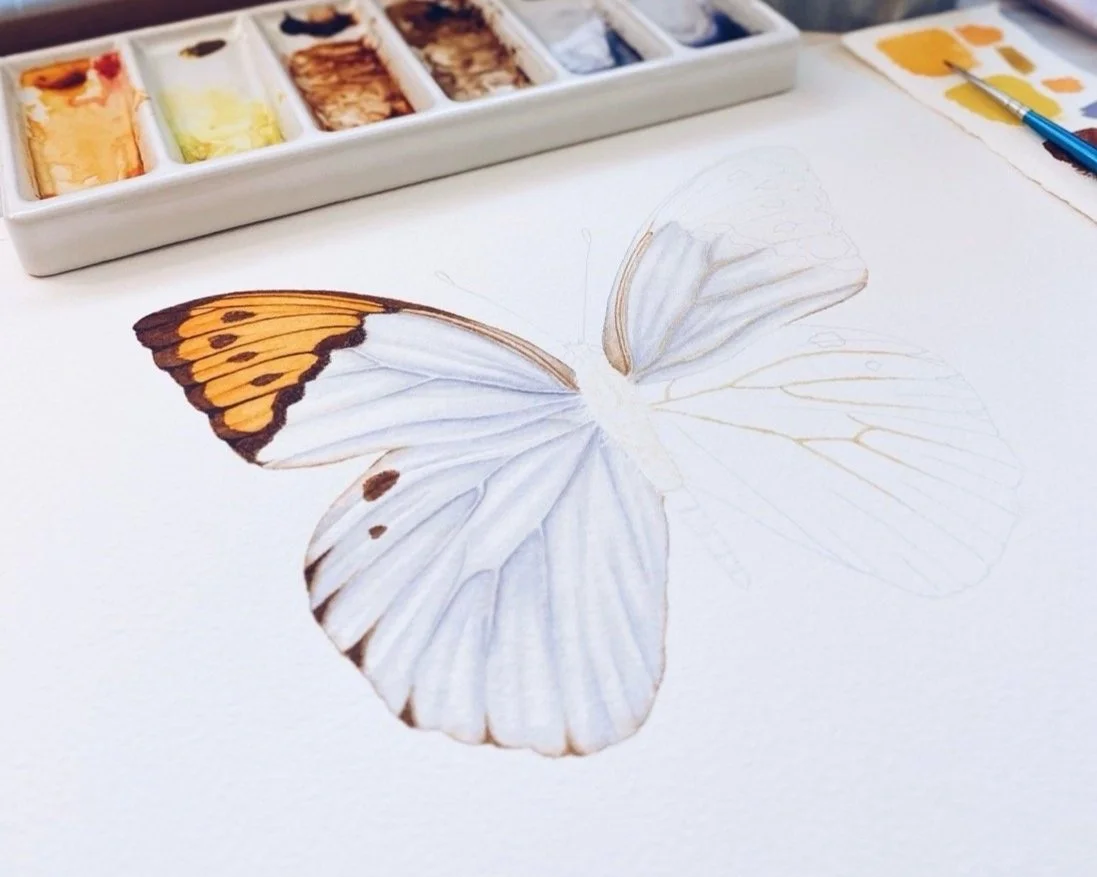Watercolour Butterflies: from Sketch to finished Painting
Every artist's journey is unique, but it typically begins with a spark of inspiration. For me, that spark often ignites while leafing through the pages of my collection of butterfly books. Each book opens a window to the magical world of butterflies, every species more enchanting than the last. The selection process is hard to explain. It’s as if a certain butterfly leaps off the page, asking to be painted. Sometimes it’s the iridescent shimmer of its wings, the gemstone-like patterns, or the story behind its name that captures my attention. This moment of connection is where the journey truly begins.
And this time, the Great Orange Tip butterfly from South Asia is the chosen one!

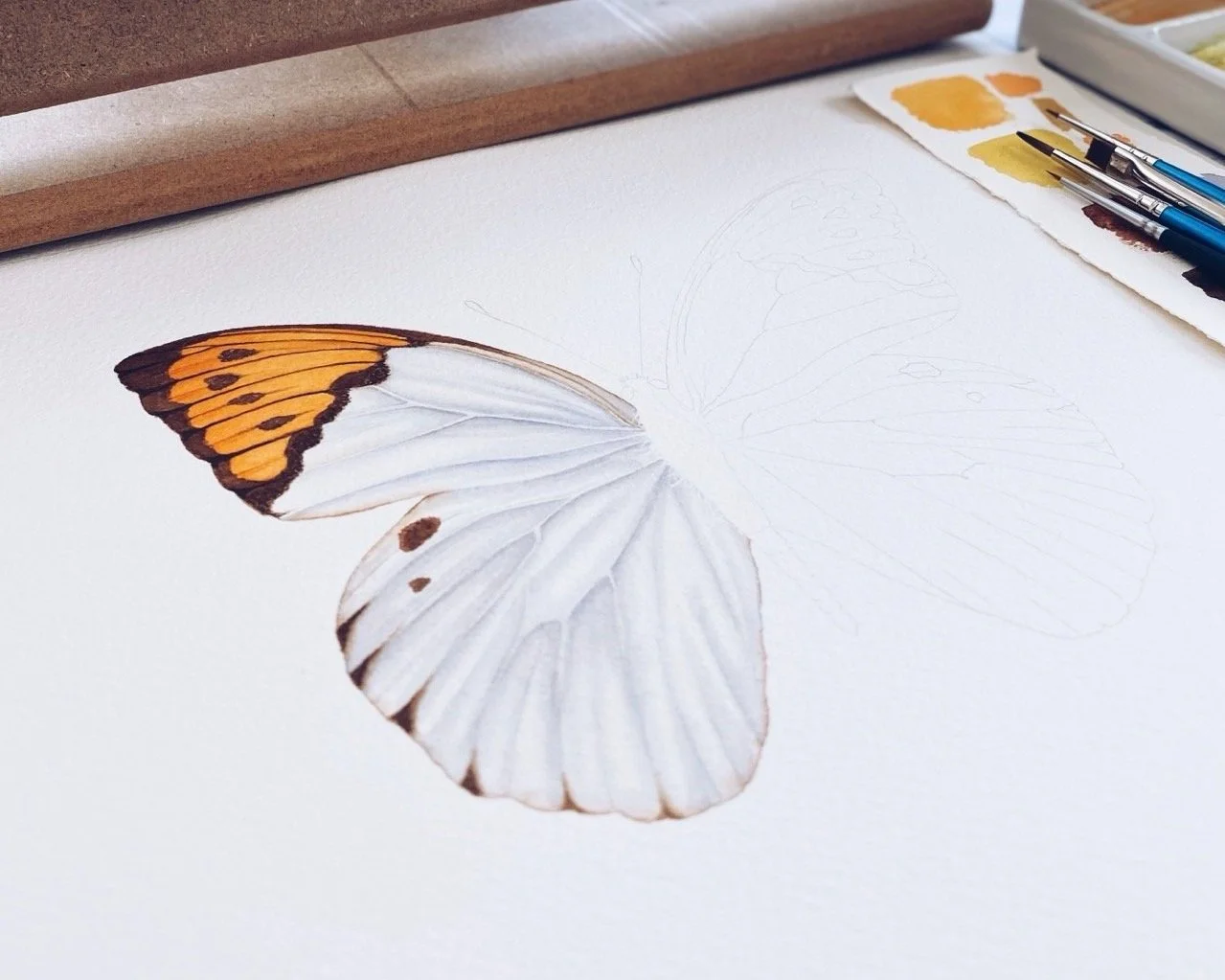
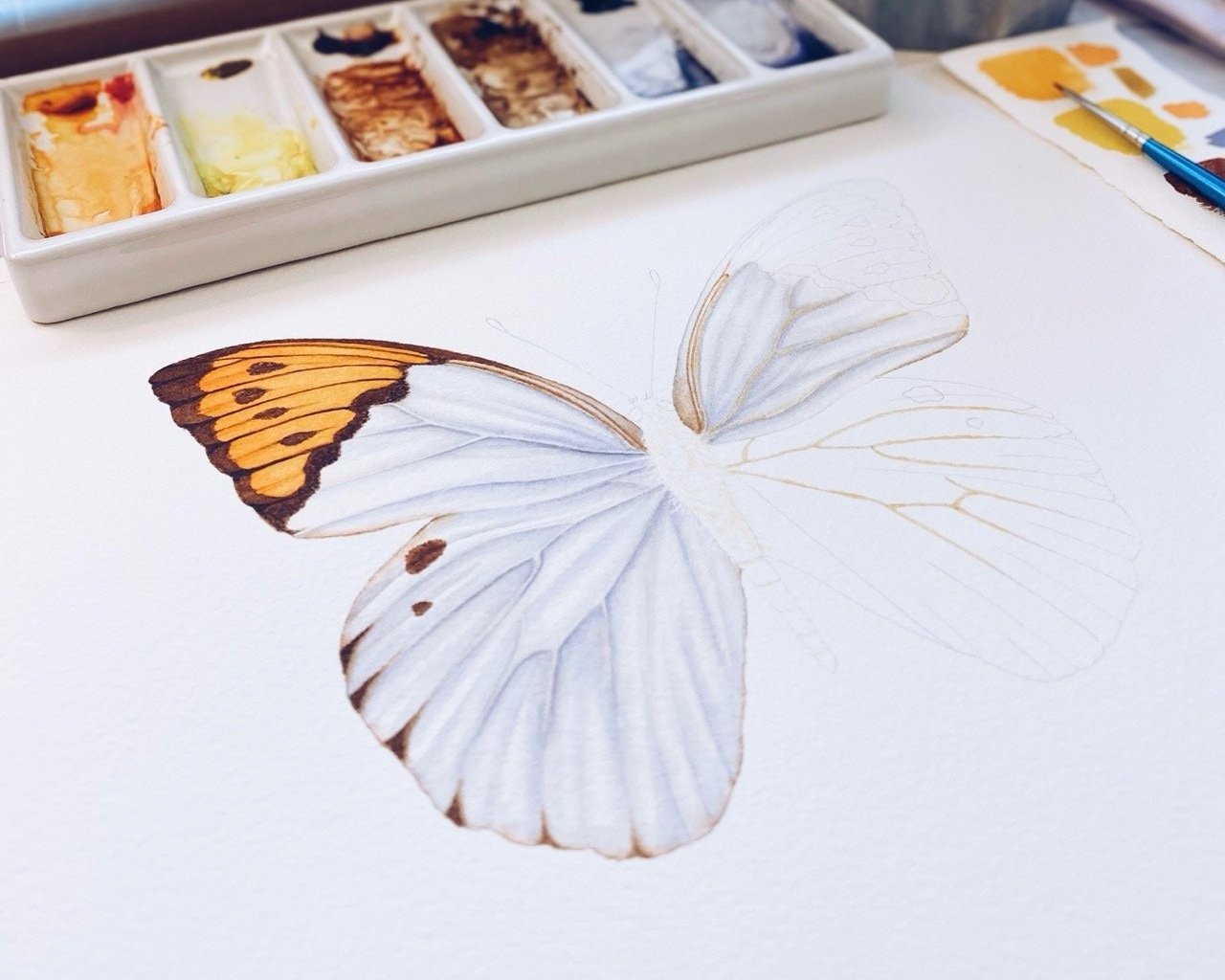
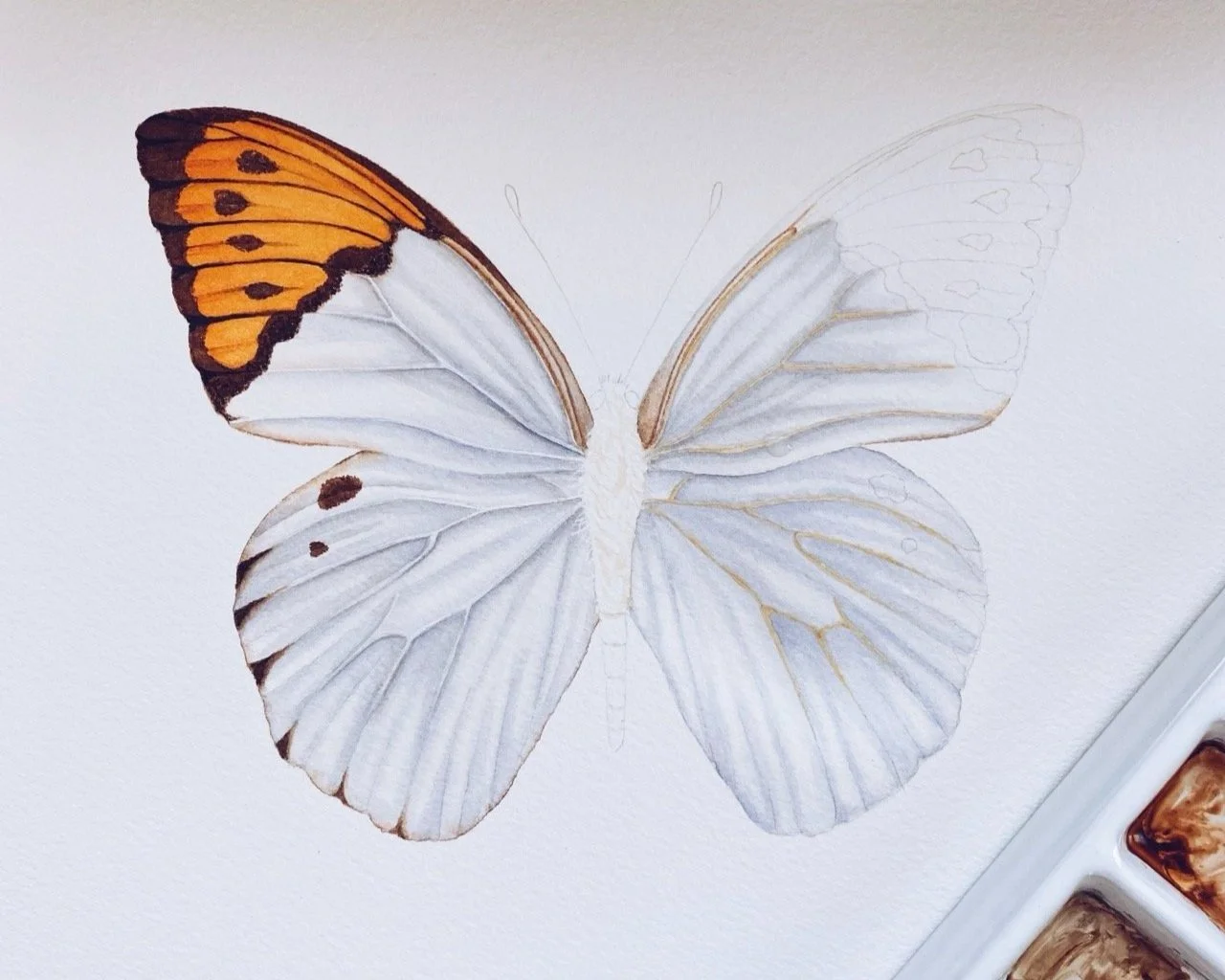
About the Species
Scientific Name: Hebomoia glaucippe
Family: Peiridae
Wingspan: 7-10 cm
Both males and females have distinctive orange patches that paint the upper edges of their creamy white wings. The underside of the wings, however, tells a different story, one of survival and adaptation: the colour is a light brown, and the patterns mimic the surface of a dead leaf when the butterfly is resting on the ground. This remarkable camouflage allows the butterfly to blend seamlessly into its surroundings, evading the watchful eyes of predators.
THE PERFECT REFERENCE
Once a butterfly captures my heart, the hunt for the perfect reference photo begins. Nowadays, we are lucky to have many resources at our fingertips, but the search can be both exciting and daunting! Websites like Raw Pixel and Wikimedia Commons offer a fantastic selection of photos under the CC0 license, many of which are in the public domain. This means I can use these images freely without worrying about copyright infringements. Unsplash, Pexels and Pixabay also offer a great variety of amazing photos; however, finding that particular butterfly I have decided to paint can sometimes turn into an extensive research project. When using these resources it's important to review the licensing of each image, as some might require attribution or have restrictions on commercial use.
One of my favourite websites is Wildlife Reference Photos as it is designed with artists in mind! You can use their photos as a reference for your artwork, which you are then free to sell, enter into competitions, display in galleries or exhibitions, and license. They have a huge selection of photos that you can purchase for just £5 each (roughly $6.50), which is incredible considering how expensive stock photos usually are!
THE SKETCHING
With the perfect reference in hand, I am now ready for the initial sketching. I usually sketch on standard printing paper and then transfer my drawing onto watercolour paper using a light pad. I start with the body and one of the wings, then sketch the other wing to ensure both sides of the butterfly are as symmetrical as possible.
Fun Fact: did you know that butterflies are known for their symmetrical wings because all cells on both wings have the same genetic code? So fascinating! However, there are rare exceptions known as gynandromorphs. But that's another story!
THE COLOUR PALETTE
The next step is choosing a colour palette. I love taking my time experimenting with different hues, as finding the right palette sets the tone for the entire painting. I usually begin by blending and testing various colour combinations, observing how they interact and influence one another. The challenge is to keep the colours vibrant while ensuring they work harmoniously together without becoming muddy.
For this butterfly, I have decided to go with Vandyke Brown, Quinacridone Gold, Burnt Sienna (Winsor and Newton), Aussie Red Gold (Daniel Smith) and one of my favourite greys mixed using French Ultramarine and Burnt Sienna.
A MINIATURE TRIAL
Instead of starting directly with the final painting, I often opt to create a smaller version first. A mini-trial is a valuable step in the creative process and serves multiple purposes. It acts as a rehearsal, allowing me to identify any potential issues and refine my techniques before committing to the larger piece. If successful, this trial not only boosts my confidence but offers an alternative perspective on the subject, and this smaller piece becomes an artwork in its own right that I can add to my collection.
THE PAINTING PROCESS
Most of the time, I begin my paintings with the wet-on-wet technique, letting the colours flow and blend on the paper. I then shift to a wet-on-dry approach, focusing on depth, definition, and the finer details that bring the butterfly to life. I usually start with the wings, then move on to the body.
When painting a butterfly with white or transparent wings, I prefer working with layers of very diluted paint to avoid going too dark too soon. For this butterfly, rather than painting the veins directly, I have opted to use some masking fluid to preserve the white of the paper and subtly paint the shadows around them to achieve a softer look.
REFLECTION AND REFINEMENT
Once the painting is completed, I let it sit in my studio for a day or two. I then photograph the artwork and study the image, looking for any elements that may need fine-tuning. This step often highlights subtle nuances that I might have missed, like adding another layer of paint in certain areas or a few extra details elsewhere.
THE ULTIMATE REWARD
From the first spark of inspiration to the final brushstrokes, the journey of a butterfly painting is thoroughly rewarding, a reflection of the complexities and joys we artists experience during the creative process. Every artwork represents a chapter in an ongoing narrative. A narrative that speaks of the beauty of nature, the challenge of capturing it on paper, and the personal growth accompanying every painting.
This journey, with its highs and lows, its moments of doubt and excitement, is what defines us as artists. It's a journey that never truly ends, as each finished piece is but a stepping stone to the next adventure, the next project, and the next breathtaking moment of inspiration.
“Painting is just another way of keeping a diary.”
MY BUTTERFLY BOOK RECOMMENDATIONS:
BUTTERFLIES AND MOTHS by David Carter, Published by DK
THE WORLD ENCYCLOPAEDIA OF BUTTERFLIES & MOTHS by Sally Morgan
BUTTERFLIES OF THE WORLD by Adrian Hoskins
BUTTERFLIES OF THE UNITED ARAB EMIRATES INCLUDING NORTHERN OMAN, by Gary R. Feulner, Binish Roobas, Victor Hitchings, Herbert HH Otto, Oscar Campbell, Huw GB Roberts, Richard J. Hornby, Brigitte Howarth
